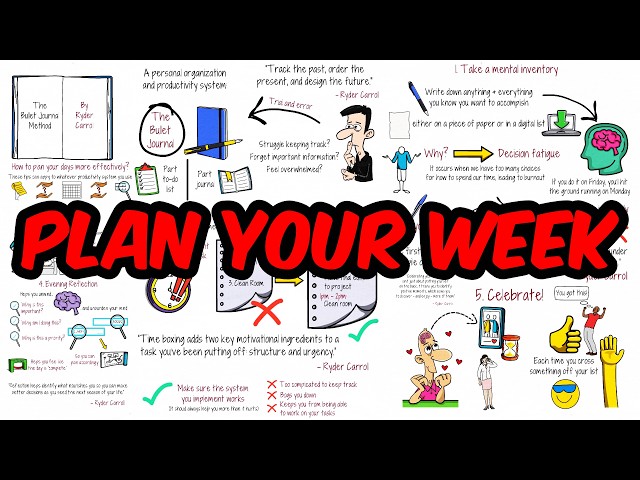Managing your week productively helps you stay organised and focused. It improves how you handle tasks, deadlines, and home routines. Many readers on Inserior follow simple methods to plan their week with clarity. You can use these steps to create a balanced and productive weekly structure.
Why Weekly Planning Matters
Weekly planning helps you understand your workload. You gain a clear picture of what needs to be done and when to do it. This reduces stress and prevents overwhelming days. A planned week also supports better home management. You complete chores, appointments, and personal goals with more control.
When you map out your week, you avoid last minute pressure. You move through your tasks with steady progress.
How to Start Planning Your Week
You can plan your week with basic steps. It does not require complicated tools. A simple routine works best.
Review Your Previous Week
Look at what you completed last week. Notice tasks you postponed. Identify areas where you spent too much time. This helps you improve your next plan.
List All Tasks for the Coming Week
Write all tasks you need to complete. Include work tasks, home responsibilities, appointments, and personal goals. A clear list helps you stay organised.
Organise Tasks by Priority
Sort tasks into high, medium, and low priority. This helps you focus on what matters most. Do high priority tasks early in the week when your energy is higher.
Use a Weekly Planner or Calendar
Add your tasks to a weekly planner. Assign days to each task. Leave small gaps for unexpected events.
Use Time Blocking for Better Productivity
Time blocking helps you organise your day into focused sections. Many readers on Night Innovations use this method to stay consistent.
Create Morning Blocks
Plan important tasks in the morning. Most people have more energy at this time. Use this block for work, study, or major home tasks.
Create Afternoon Blocks
Use afternoons for ongoing tasks. This includes cleaning, planning, errands, or light work.
Create Evening Blocks
Use evenings for light tasks like preparing for the next day or organising your space.
Use Break Blocks
Add short breaks between your tasks. Breaks help you maintain your energy.
Keep Your Week Balanced
Balance prevents burnout. You manage your time better when you distribute tasks evenly.
Avoid Overloading a Single Day
Spread tasks across the week. Avoid adding too many tasks to one day. This improves your focus.
Add Buffer Time
Buffer time helps you handle delays. Add fifteen to thirty minutes between tasks.
Include Rest Days
Add a day with fewer tasks. Rest improves your productivity for the rest of the week.
Use Tools to Stay on Track
Tools help you maintain your weekly plan. They keep you organised and consistent. Many readers on Info Tech Share use these tools to manage their schedule.
Use a Task App
Apps with reminders keep you on track. They help you avoid forgetting important tasks.
Use a Weekly Checklist
A checklist helps you follow your routine. Tick off each completed task. This builds motivation.
Use Sticky Notes
Sticky notes help you highlight important reminders. Place them where you can see them.
Build Habits That Support a Productive Week
Strong habits improve how you manage time. You can build them through simple actions.
Prepare at Night
Prepare your next day’s clothes and items. This saves time in the morning.
Tidy Your Space Daily
A clean environment keeps your mind clear. Spend five minutes each day organising your room or desk.
Follow a Morning Routine
Start your day with a stable routine. Drink water, stretch, and review your plans. This builds momentum.
Set Weekly Goals
Weekly goals guide your direction. They help you focus on what matters most.
Use Simple Goals
Choose goals that are realistic. For example, complete a work project, organise a room, or exercise three times a week.
Review Goals Every Sunday
Check what you achieved. Identify what needs improvement. Adjust your goals for the next week.
Stay Flexible When Needed
Flexibility helps you manage unexpected changes. Your plan should support your life, not restrict it.
Adjust Your Tasks
If a task takes longer than expected, move it to another day. Avoid rushing.
Use Backup Tasks
Use small backup tasks for extra time. This includes organising a drawer, replying to messages, or planning meals.
Track Your Weekly Progress
Tracking helps you understand how productive your week has been.
Write a Simple Summary
Write a short summary at the end of the week. Highlight what worked and what needs changes.
Track Your Time
Note how long tasks take. This improves future planning.
Use Weekly Reflections
Reflect on your mood, energy, and productivity. This helps you create better weekly routines.
Seasonal Adjustments for Weekly Planning
Your routine may change with the seasons. You can adjust your weekly plan for better balance.
Adjust for Winter Weeks
Days are shorter. Complete outdoor tasks early. Use bright lighting for indoor tasks.
Adjust for Summer Weeks
Use early mornings for tasks that need focus. Add hydration reminders.
Prepare for Seasonal Tasks
Add seasonal home chores to your plan. This includes deep cleaning, repairs, or garden tasks.
Final Thoughts
Managing your week productively helps you stay calm, organised, and focused. You complete tasks with clarity. You balance work and home routines with ease. You can follow these simple steps to build a strong weekly structure. Many readers on Info Tech Share use these methods to stay on top of their schedule and create steady progress.



